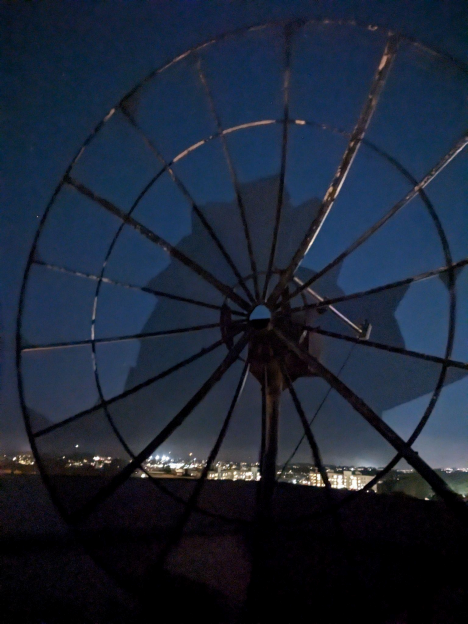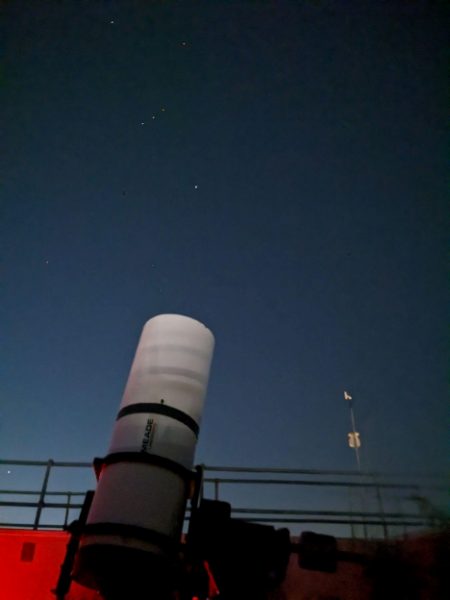June 13, 2024

By: AEOP Membership Council Member Gordon Chen
Sitting on my red folding chair, my eight-year-old self stares at the warm, bright campfire nearby, which contrasts heavily against the cold, dark night surrounding me. The only noises I can hear are the sounds of my breath and the crackling of the flames. As I stretch my ice-cold hands forward to warm them, I watch as the wisps of smoke twist and turn, gradually rising into the sky. Through the light haze of smoke above my head, I see the occasional twinkle of a star. While I gaze at the sky around the knobby half dome through the towering pine trees around my campsite, a dazzling light streaks past in the sky, and I watch in surprise. I start looking at the seemingly random patterns of stars in the sky to see if any combinations resemble objects I can think of.
Thirteen-year-old me holds a long wooden skewer with a fluffy marshmallow. As I rotate it just above the smoldering remains of the campfire, I decide to relax for a while as I gaze at the stars. I can recognize the three collinear stars that form Orion’s Belt, as well as the Big and Little Dippers, and even the white stripe of the Milky Way. As I motivate myself to learn more about the interesting world of constellations and how they were made to fit the stars, out of the corner of my eye, I catch a shooting star flash by. Excited, my hand shakes, and the marshmallow drops into the fire. While putting another marshmallow on my stick, I tell myself that I will start tracking the activities of celestial bodies. These experiences empowered my decision to try to learn more about the stars that shine above us.
 In 2020, I joined a great conjunction star party, where I witnessed an inspiring celestial event. I made many new friends and gained valuable insights into how various telescopes function. I admired the stunning beauty of the night sky when viewed up close. After learning how to select the right telescope, I discovered the importance of factors, lens size and base stability. Upon returning home, I gazed up at the sky and noticed a startling difference compared to the clear views from national parks. To escape light pollution, I hike to Mission Peak and bring my telescope. Standing on top of the mountain, I am greeted by a breathtaking night sky.
In 2020, I joined a great conjunction star party, where I witnessed an inspiring celestial event. I made many new friends and gained valuable insights into how various telescopes function. I admired the stunning beauty of the night sky when viewed up close. After learning how to select the right telescope, I discovered the importance of factors, lens size and base stability. Upon returning home, I gazed up at the sky and noticed a startling difference compared to the clear views from national parks. To escape light pollution, I hike to Mission Peak and bring my telescope. Standing on top of the mountain, I am greeted by a breathtaking night sky.
Now, at sixteen years old, I recline in the same red folding chair while warming my hands by a dying campfire. I’ve been keeping track of recent and relevant astrophysics events, including the first image of a black hole, super blood moons, lunar and solar eclipses, and meteor showers like the Geminids. It’s exciting to stay up late just to catch a glimpse of these amazing events. But the sky was not as clear as when I was young. I wonder if it’s because I wasn’t standing high enough, or if it’s due to pollution.
Environmental factors like light pollution and ground stability can impact the clarity of star observation. Concerned about pollution’s impact, I researched its effects and learned about strategies to reduce it. Pollution primarily stems from vehicles, the gas used to heat our homes, emissions from power generation and the release of chemicals in our daily activities. Wildlife suffers from pollution’s impacts. Before the Industrial Revolution, some moth species were white to blend with their natural tree habitats. However, due to industrial pollution, these trees became stained black, leading the moths to adapt to show a darker color.
Another significant side effect of pollution is global warming. When we burn fossil fuels, we release carbon dioxide trapped within the atmosphere. This disrupts the natural balance of greenhouse gasses, trapping heat that would otherwise escape into space. The overall global temperature increases, leading to more extreme weather patterns worldwide. Species like the golden toad have become extinct due to climate change, which alters habitats beyond their ability to adapt.
On the bright side, there are many strategies for reducing pollution. In California, any cars sold after 2035 must be a zero-emission vehicle. This policy will gradually decrease the use of gasoline cars, reducing emissions and overall pollution levels. Numerous international organizations are already implementing pollution-elimination plans and creating countermeasures to combat pollution.
These laws can significantly help in the fight against pollution, but it’s not solely the government’s responsibility. We all play a role! Raising awareness about pollution and its effects is a crucial step. Solving these issues is vital for a cleaner planet and clearer skies for stargazing. Let’s join forces and ensure those little stars twinkle happily in the sky!
Find a Volunteering Opportunity
Visit our Program Volunteers page for a tool to find the best opportunity for you.
eCYBERMISSION Mini-Grant
The eCYBERMISSION Mini-Grant is intended to support teachers/program leaders as they implement eCYBERMISSION with their teams. Educators (formal and informal) of students in grades 6-9 are encouraged to apply.
